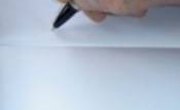
One of the first steps in crafting an effective essay is asserting a controlling idea or main idea. The controlling idea of the essay states your driving opinion, belief or argument regarding the essay topic and is typically the topic sentence, not necessarily the first sentence. A strong controlling idea is broad enough to include multiple examples and perspectives, but focused enough to keep the essay on a logical and easy-to-follow track. Once you've located your controlling idea, you are prepared to extend the idea into a thoughtful, well-rounded essay that provides evidence to support your position.
Prewriting
As prewriting, prepare a graphic organizer to provide a visual guide for the writing process of your essay. One approach to a graphic organizer is a box web. At the top of a piece of paper, write your broad topic, such as "Romeo and Juliet". Draw a line from the topic to a box. Draw three lines from the box to three smaller boxes. Draw three additional lines connecting the three boxes to a single box at the bottom of your paper. This will help with brainstorming around the central idea for the topic of the essay.
Write your controlling idea in the first box of the organizer. The controlling idea is the main point, position, opinion or argument you will defend in your essay. For a paper on "Romeo and Juliet," a controlling idea might be "Juliet is a feminist character" or "'Romeo and Juliet' is Shakespeare's most tragic play." The controlling idea should not be a simple statement of fact, but rather an arguable position that asserts your stance on the issue.
Write a concrete example in each of the subsequent three boxes that supports your controlling idea. The examples may be quotations from a text, excerpts from research papers or statements from experts that support your position. Use only one example per box. Beneath each example, write a phrase that demonstrates how the example supports your controlling idea.
Rephrase your controlling idea in the final box of the graphic organizer. The statement should reassert your position but sound distinct from your controlling idea statement. If your controlling idea statement was "'Romeo and Juliet' is Shakespeare's most tragic play," your rephrasing statement might read, "Both the number and the poignancy of the deaths in 'Romeo and Juliet' make the play Shakespeare's most tragic work."
Writing your essay
Refer to the first box in your graphic organizer to write your thesis statement in your introductory paragraph. The thesis statement should contain both the general topic of your paper as well as your controlling idea. A thesis statement might read, "Though Shakespeare composed many tragic plays, 'Romeo and Juliet' stands alone as his most tragic work." Write at least three subsequent sentences that clarify your first statement, summarize the direction of your essay and conclude the paragraph to transition into specific examples.
Refer to your first supporting evidence box to compose your first body paragraph. The body paragraph should appropriately cite your piece of evidence and clearly connect it to your controlling idea at the beginning of the paragraph. This will be the main idea of the paragraph. Include a concluding sentence that firmly reasserts your controlling idea based on the evidence. For example, your first body paragraph might conclude, "The depiction of Juliet as youthful and innocent makes her subsequent death even more tragic than the deaths of less sympathetic Shakespeare characters."
Compose an additional two body paragraphs using your two remaining evidence boxes in the same way previously outlined. These will be your supporting details.
Conclude your essay with a final paragraph that summarizes your main arguments and asserts your controlling idea as rephrased in your last text box in your graphic organizer.
Tip
Avoid "guiding" phrases like, "In conclusion" or "My first point is". They distract the reader and add unnecessary bulk.
Do not mention the essay in the essay. For example, do not include, "In this essay, I will do the following" or a similar phrase in your opening paragraph.
Always read through your essay for revising.
Related Articles
References
Tips
- Avoid "guiding" phrases like, "In conclusion" or "My first point is". They distract the reader and add unnecessary bulk.
- Do not mention the essay in the essay. For example, do not include, "In this essay, I will do the following" or a similar phrase in your opening paragraph.
Writer Bio
Hannah Wahlig began writing and editing professionally in 2001. Her experience includes copy for newspapers, journals and magazines, as well as book editing. She is also a certified lactation counselor. She holds a Bachelor of Arts in English from Mount Holyoke College, and Master's degrees in education and community psychology from the University of Massachusetts.









